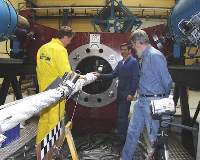FRANCE: Evaluating synthetic mooring lines for deepwater use
April 2001 Vol. 222 No. 4 Feature Article FRANCE: Evaluating synthetic mooring lines for deepwater use The use of polyester fiber mooring lines in deepwater E&P
FRANCE:Evaluating synthetic mooring lines for deepwater useThe use of polyester fiber mooring lines in deepwater E&P operations was pioneered by Petrobras, and high performance polyethylene (HPPE) ropes also were used recently in a temporary application. But the optimization of mooring designs using synthetic cables is critical to deepwater exploitation. A French consortium led by IFREMER, the French Ocean Research Institute, recently began Phase 3 of a project aimed at improving the design of synthetic rope mooring systems for both temporary and permanent operations. Project partners include IFP, Bureau Veritas and engineering companies Bouygues Offshore, Doris and Technip.
In Phase 2 of the project (completed in 1999), polyester ropes were tested to break loads up to 700 tons. Creep behavior of smaller ropes, yarns and fibers also was characterized. Results were presented at ISOPE 99 and OTC 2000. Stiffness data generated under a wide range of loading conditions enabled conventional mooring line analyses to be adapted to polyester mooring lines. Bureau Veritas presented the new analysis approach at the Rio Oil & Gas 2000 Conference last October. In parallel with Phase 2 test programs, in situ stiffness measurements also were performed on a 500-ton break-load polyester insert installed by Elf off West Africa. Results from this study were presented at ISOPE 99. Objectives of Phase 3 are twofold. First, the stiffness database will be extended to include HPPE and Aramid ropes. These materials are being examined in order to allow the engineering companies involved in the project to more precisely define the operating depth limitations of the various materials. At present, a full set of stiffness data, including influence of mean load, load range, frequency and load frequency superposition effects, is not freely available. Reliable, independent data is essential, if different concepts are to be compared for water depths down to 3,000 m (9,845 ft). Tests on full-size ropes made with these materials started in February this year. The development of reliable test procedures for these ropes is an important part of the study and various extensometry systems are being evaluated. Accurate measurement of small displacements is of paramount importance in these tests, as the extensions typically are a factor of five smaller than those recorded for polyester ropes. The second goal is to study long term behavior of
smaller polyester, Aramid and HPPE ropes. These will be examined by creep and creep-rupture loading on
machines rated up to 100 tons at IFREMER and IFP. These tests will be complemented by more fundamental studies
at the yarn and fiber level. Completion of this project phase is planned for 2002.
|
- Applying ultra-deep LWD resistivity technology successfully in a SAGD operation (May 2019)
- Adoption of wireless intelligent completions advances (May 2019)
- Majors double down as takeaway crunch eases (April 2019)
- What’s new in well logging and formation evaluation (April 2019)
- Qualification of a 20,000-psi subsea BOP: A collaborative approach (February 2019)
- ConocoPhillips’ Greg Leveille sees rapid trajectory of technical advancement continuing (February 2019)



